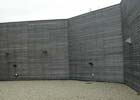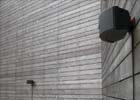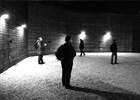

CLAUSTRUM
2011 - site-specific sound installation
(Le ceneri di Gramsci by Pier Paolo Pasolini, voice: Pier Paolo Pasolini)
8 channels, 16’
CLASTRUM
2011 - installation viewt
CLASTRUM
2011 - installation view
CLAUSTRUM – exerpt (Movement VI) – voice: Pier Paolo Pasolini
installation sound
Concept
CLASTRUM
L’opera evoca già nel titolo la forma cinta e chiusa tipica dei chiostri monastici, spazi che solitamente invitano alla deambulazione, al silenzio e alla preghiera. Le ceneri di Gramsci, costituite da undici poemetti pubblicati in un unico volume nel 1957, e definite dallo stesso Pasolini “la poesia dell’ideologia” poiché nate in un delicato momento della cultura di sinistra, rappresentano il prestito narrativo dell’installazione sonora. Modulato in dodici sequenze, secondo temi quali la natura, il corpo, la vita, il mistero e il tempo, il percorso audio messo a punto dall’artista fonde le vibrazioni ambientali della corte (il Claustrum) e la determinatezza delle parole recitate dallo stesso Pasolini, dando vita ad un’entità acustica ibrida dove ad ogni parola può corrispondere un passo, un respiro, un battito. La molteplicità di significati contenuta nel lavoro si esprime così attraverso l’orchestrazione del particolare rapporto tra il linguaggio e l’immagine evocata dalla parola. Il sacro diventa dunque poesia per fecondare il corpo di realtà, per far parlare le cose attraverso la mente e l’emozione – che per Pasolini è passione. E la sacralità coincide con i gesti e le cose semplici del quotidiano, riconducibili alle azioni e agli impulsi del corpo come il respirare o l’involontario movimento del cuore (che siamo abituati ad ascoltare senza sentire) per arrivare alla morte e alle sue ceneri, simbolo ultimo di unione tra l’essenza materica umana e la terra che la conserva.
CLASTRUM
Already the title of the work is evocative of the walled, closed form typical of monastic cloisters, spaces that usually invite strolling, silence, prayer. Le ceneri di Gramsci, comprising eleven short poems published in a single volume in 1957, and defined by Pasolini himself as “the poetry of an ideology” since they were written at a delicate moment in left-wing culture, comprise the narrative borrowed by Dario Neira for his sound installation. Modulated in twelve sequences organised around themes such as nature, the body, life, mystery and time, the artist has set up an 8-channel audio sequence that blends the environmental vibrations of the courtyard (the Claustrum) and the determination of the words recited by Pasolini himself. The result is a hybrid acoustic entity, in which, to each word, may correspond a step, a breath, a beat. The multiplicity of meanings contained in Neira’s work is thus expressed through the orchestration of the particular relationship between language and the image evoked by the word. The sacred thus becomes a poetry to fertilise the body of reality, to make things speak through the mind and through emotion – which for Pasolini is passion. And sacrality coincides with the simple gestures and articles of daily life, that can be related to the actions and impulses of the body, like breathing or the involuntary movement of the heart. Culminating in death and its ashes, the ultimate symbol of the union between material human essence and the earth that conserves it.









